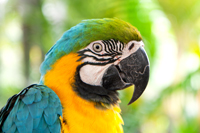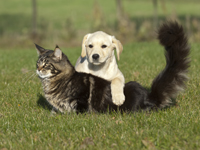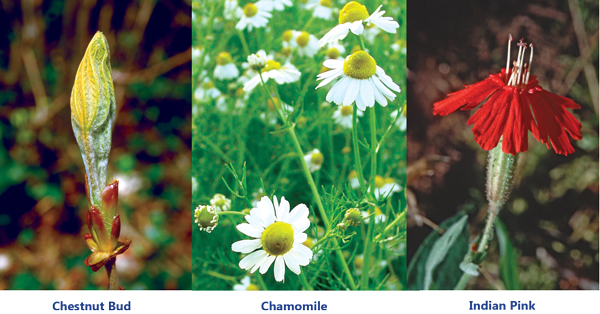|
by Jann Garitty Everything is changing much faster then ever before, and though moving fast, we still have to deal with it all. Flower essences can provide self-support for a foundation to help with this. That’s more important now than ever before. I’m trying to help people to understand that they don’t have to wade through and suffer through what’s happening. Flower essences can’t go wrong and cause harm; they can be amazing! — Nedda Wittels
”I really could feel the effects; emotional issues were released and cleared…I was fascinated.”
Using flower essences for caretaker and animal
Recognizing that animals have feelings
An animal communication session with Nedda
Establishing healthy boundaries and easing anxiety
From abandonment and emotional pain to a whole new life
Nedda Wittels was aware of flower essences and knew that they could be of great benefit for emotional issues. She also knew they would be a good adjunct to her work as an animal communicator. Nedda was acquainted with a flower essence practitioner named Kathy Le Donne, and in her first year of developing her business, Nedda spoke with Kathy about learning more in depth about flower essence therapy, explaining “I had plenty of emotional issues with which to work, and wanted to do deeper work with flower essences to experience them in my own body.” Nedda met with Kathy for an hour each session, telling her what was going on in her life at the time. Kathy would send her home with a formula. These meetings with Kathy occurred every 2 to 2-1/2 weeks and Nedda “moved through a lot” in 8-10 sessions. ”I really could feel the effects,” she said, “I worked through many levels of emotional issues quickly. They were released and cleared so fast. I was fascinated!” Nedda then learned about muscle testing, and bought and studied Bach essence books. She began suggesting flower essences to animal communication clients where an emotional component was significant if the human client agreed to try them. She always emphasized that flower essences are not harmful, do not conflict with anything else, and are safe. When first beginning to incorporate the essences into her practice, and while she still did not know them all that well, Nedda worked from higher guidance. She would pick a couple of essences of which she was certain, but often sensed she was missing one, and would ask via muscle testing, “Do we need another flower essence? Yes or no…” Next she would narrow down the choice range, for example, “Is it an essence in the alphabetical range from a-m? n-z?” etc. When the missing essence was finally identified by muscle testing, reading the description always confirmed the selection. She used that method for quite some time until her intuitive abilities to choose the essences matured. Now, the names of the needed essences often pop right into her head and muscle testing helps verify anything where she has a question about the message from higher guidance.
Nedda has worked with a very wide range of animals, including llamas, bunnies, guinea pigs, and even a pet tarantula. While most of her clients are cats, dogs, or horses, she has also worked with birds, who she considers wild, even though they may be in relationship with humans. Nedda explains, “Birds in captivity are wild in that they are not really genetically different from birds in nature. They’re also very sensitive.” Unfortunately, many are mistreated and mishandled out of ignorance. Flower essences can be of great benefit to them. Nedda recommends that if a bird owner is concerned about the alcohol, the essences can be put in the bird’s drinking water and allow it to sit open for 10 minutes so the alcohol will evaporate. One may also put drops of essences on the skin above their beaks.
Using flower essences for caretaker and animal
Most of the time Nedda is speaking with a female human, and sometimes the woman will say, “My husband needs flower essences, too.” She will make suggestions and discuss them, finding out later that the man felt so much better. The woman too, may wish to discuss essences to include for herself, in addition to the same essences used with the animal. Sometimes the whole family will use essences. In some families, the animal is more connected to the man or the woman in the family, and it is the animal dynamic that needs to be addressed. The key person in relationship with the animal often benefits from using the same essences as the animal as well. When integrating animals into a family, everyone can benefit from taking flower essences, “Essences work wonderfully to help with that,” Nedda remarked.
In general, Nedda recommends misting Five-Flower Formula in home environments: “I tell people to mist their homes. I found it so helpful myself after the roof on my house was fixed. When the workmen left, the energy in the house was chaotic for all of us. So I misted the house. The energy shift was dramatic; everything immediately calmed down and the cats and I breathed a big communal sigh of relief.”
Recognizing that animals have feelings Nedda makes formulas for her cats and herself when needed. One of her cats, Sakhara, has been through much trauma in her life. She had kittens at a young age while at the Humane Society and then fostered many other kittens while there. The food that was fed did not adequately support her nutritional needs at that time. Despite a good diet since living with Nedda, she needed dental surgery because of poor teeth. The surgery was long and difficult for her. Rescue Remedy ( aka Five-Flower Formula ) given immediately afterwards was of enormous benefit to her recovery.
However, when Sakhara had to go back to the veterinarian, she was literally shaking with fear. Nedda made her a formula which included Five-Flower Formula, Mimulus, Aspen , and Chamomile. Now, whenever she goes to the vet she uses it. While it may not completely alleviate her fears, she no longer shakes like a leaf. Nedda believes, “It’s important that we recognize that animals have feelings. We can’t just say ‘It’s going to be fine’ and expect that to be enough to calm them. Because of the essences we actually help them.” People often call Nedda and ask about animals who aren’t responding to them. Animals coming from rescue situations may be very confused. Nedda says, “Many are unable to respond because their hearts are closed and so they do not connect.” Nedda is able to feel if an animal’s heart is shut down, and helps to orient them. This assists them in bonding with their new human families. Holly, Mariposa Lily, Bleeding Heart, and other heart-centered essences are greatly helpful in those situations in addition to telepathically helping an animal release their emotional blocks. This is an example of how animal communication, supported by flower essences, greatly increases the speed with which an animal can recover from emotional trauma. Nedda also proposes that Walnut, Chamomile, and Five-Flower Formula should be used in every rescue organization as part of their basic routines: “If someone just went through the facility misting the essences a couple of times a day, everything would calm down. And, the same might be said for veterinary practices, as well.”
An animal communication session with Nedda Typically, a person will write to Nedda via email requesting a communication session with their animal or in some cases, for more than one animal in the family. During the subsequent phone session (which doesn’t require a photo of the animal unless it is lost or missing), Nedda asks for a description of all animal family members. She has found this to be important in case some other animal pops into the conversation, which sometimes does happen. Nedda needs to know with whom she is talking. She then asks the client, most frequently a woman, “What event or series of events brought them to contact her? What are their goals?” Nedda next makes a mental connection with the animal – a “live simultaneous translation” occurs during the conversation as she describes to the human what she senses, sees, feels, and hears from the animal. She “talks” to the animal and also verbalizes to the human at the same time. In this way, if anything needs to be negotiated, everyone is right there. Also, the human gets to experience what it is like to have a conversation with their animal. It’s a two-way communication and everyone is involved. Nedda has always been able to communicate telepathically, and has developed her techniques for communicating in this way over time. She teaches her professional animal communication mentees how to do this as well.
As emotional issues surface, flower essences come into her mind, and Nedda starts making a list. She’ll begin to speak about the flower essences, refining the issue by asking specific questions of the animal. As an emotional empath, Nedda can feel what the animal is feeling as he or she tells Nedda about it, and this has become the main way Nedda knows which essences to choose. She will then explain to the animal and human how the essences work, including the fact that they do not interact with medications, etc. Nedda specifically asks the animals if they are willing to take essences, treating them respectfully because they have consciousness and can make choices for themselves. Most animals want to try the essences because they want to feel better. Nedda also teaches her clients how to use Rescue Remedy or Five-Flower Formula to desensitize their animals for nail clipping, grooming, and taking medications. She explains to clients that they should first take some of the formula themselves in their own mouths to make sure they, themselves, are calm. The next step is to put some of the formula on their hands and stroke the animal. It’s also important to explain to the animal what they are doing and why. Finally, putting the essence on the animal directly and onto a grooming tool or nail clippers aligns everyone and everything vibrationally. “Then, and only then,” Nedda commented,“ is it okay to proceed to the next steps of teaching yourself and your animal to take medication or have nails clipped or whatever the case may be.”
Establishing healthy boundaries and easing anxiety A woman, who has four cats and a German shepherd who was adopted from a rescue organization, called Nedda to communicate with her dog. The dog had been with the family for awhile and they had worked through some issues, but suddenly things were not okay. The dog had been chewing on doors and gates. He had gotten a foxtail stuck in his cheek, which was very painful, and the woman couldn’t get it out. She took him to a veterinarian and he went “bananas” and tried to bite the vet. The dog had never done that before. Over the course of several appointments, Nedda discovered in communicating with him that he had basic insecurity and anxiety attacks which are triggered by many different things. His human had to travel often and whenever she went away, he would have an attack.
The dog expressed that he didn’t want the vet coming near him, or using a muzzle and tranquilizers. The dog was not able to maintain healthy boundaries for himself because of the invasiveness, and nothing was being done to address his pain. Nedda recommended a formula for him: Mimulus and Aspen for his fears and anxiety Pink Yarrow so his auric field would have a clearer boundary Larch so he would feel like he could stand up to it all and not go to pieces Poison Oak for his anxiety about others who came into his personal space Chamomile to help him calm down
Meanwhile, he still experienced anxiety attacks whenever his person had to travel. Although he is well cared for when she is absent, he has a strong connection to her. At that point, Nedda added Mariposa Lily and Bleeding Heart to the formula so he could feel the connection with the woman and feel safe when she was gone. Most recently, when the woman called to check in with Nedda on all the animals, his only issue was that he had itching on one of his paws.
An older couple whose Doberman passed on, later brought a Doberman-Rottweiler home from a shelter. The dog had lived with a family but always had been locked in a room with another dog. It had been a full year before the workers at the shelter could introduce these two dogs to people. Someone obviously had been committed to working with them to see that ultimately they could find homes. In her new home, the dog was super over protective. She charged at people who came to the house. On the other hand, she was crate and house trained, so the family had some tools to work with. Sadly, the dog found it difficult to accept that she was safe and wouldn’t be hurt or abandoned. Rescue Remedy was used at first. Later Chestnut Bud was added to his formula because the dog had to open up and learn a great deal, Walnut was included for change, and Mimulus because she was afraid of everything. A month later, she was still using the essences and was more relaxed. The dog spent more time in the family room sitting with the couple rather than choosing to be alone. While still overprotective, charging at joggers, the couple was working with her in regard to people coming into the house. The husband wanted to put up an electric fence and have a friend of his, who did the electric fencing, train the dog. The dog had met this person, and was terrified of that trainer. The session didn’t go well at all. Nedda then referred the couple to a woman trainer who is very gentle and quiet. Eventually they called her and the dog not only adores her, but has made enormous strides. Nedda told this family to slow down in their efforts to integrate the new dog, who was overwhelmed with everything that they were trying to do. She suggested “Start where the dog is…” By slowing down and letting the dog show them when she was ready for new things, the integration has occurred beautifully. The family continued with the same flower essence formula, and later added Chamomile for emotional upset and car sickness. This rescue dog now has a whole new life and the couple has a wonderful new friend. “Once the people slowed down and worked with the dog where she was emotionally, and used appropriate essences combined with some excellent dog training, there was steady improvement,” Nedda said.
About Nedda Wittels
Visit Nedda’s informative
website
.
|
|||||||||||||

To install this Web App in your iPhone/iPad press ![]() and then Add to Home Screen.
and then Add to Home Screen.



 Nedda is also sensitive to the hierarchy characteristic among different animal species. She always wants to be sure to speak to the “top dog” or “top cat” especially in the first session, and wants to be able to call on other key members of the family as necessary. Some animals can tell her exactly what emotional issues are going on with other animals in the family and offer great insights and advice to help their human family members understand what to do to make things better.
Nedda is also sensitive to the hierarchy characteristic among different animal species. She always wants to be sure to speak to the “top dog” or “top cat” especially in the first session, and wants to be able to call on other key members of the family as necessary. Some animals can tell her exactly what emotional issues are going on with other animals in the family and offer great insights and advice to help their human family members understand what to do to make things better.






 Nedda Wittels, M.S., M.A., is a world renowned Animal Communicator, Master of Multidimensional Healing, Light Worker, and teacher who has been communicating with animals since childhood. As a small child, Nedda felt the emotions of animals empathically. She often knew what the family pets were feeling and what they wanted. Her parents told her to stop pretending, so she stopped telling others what she experienced.
Nedda Wittels, M.S., M.A., is a world renowned Animal Communicator, Master of Multidimensional Healing, Light Worker, and teacher who has been communicating with animals since childhood. As a small child, Nedda felt the emotions of animals empathically. She often knew what the family pets were feeling and what they wanted. Her parents told her to stop pretending, so she stopped telling others what she experienced. 